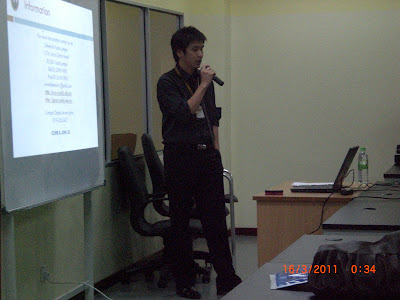we discuss, we talk, we write
Friday, April 22, 2011
Thursday, February 24, 2011
HOW TO WRITE THE EMAIL
- http://www.askmen.com/money/how_to/1_how_to.html
- http://www2.elc.polyu.edu.hk/CILL/eiw/e-mail.htm
- http://jerz.setonhill.edu/writing/etext/e-mail.htm
Monday, February 21, 2011
LETTER AND TENTATIVE PROGRAM
![]() University Kuala Lumpur IPROM,
University Kuala Lumpur IPROM,
SENDER’S ADDRESS
Taman Shamelin Perkasa,
Email: roy_ichigo@yahoo.com.my
Phone No: 017-5968580
RECIPIENT’S ADDRESS
![]()
Institute Kemahiran Mara Kuala Lumpur,
Jalan Belangkas Kg. Pandan,
55100, Kuala Lumpur.
Tel: 03-928444455/03-92844535
Fax:
TITLE OF PROJECT & OBJECTIVE
![]() REF: PROMOTING UniKL IPROM
REF: PROMOTING UniKL IPROM
Dear Sir/Madam,
We are proud to invite your student to attend our Academia Week which will be held on 14th March-18th March 2011.
There will be a variety of interesting programmes for visiting students to know our institute better. The main objective of the programmes is to provide students with information about UniKL IPROM. Another objective is to establish networking among higher education institutions expecially between UniKL IPROM and your institute. Besides that, students from your institute can exchange ideas with UniKL IPROM students.
There will also be a campus tour, other special event will be held on 16th of March. Please refer to attachment.
We look forward receiving your positive feedback by 3rd March 2011 using the email address or phone number state above. Thank you for your attention and consideration.
YOUR SINCERELY![]()
Yours sincerely,
Nor Mohd Zulfaqar Bin Baharudin
Tentative program
| DATE | TENTATIVE PROGRAM |
| 9.00 am – 9.30 am | Assemble, short briefing, Doa (Ustaz Sanusi) |
| 9.30 am – 10.30 am | Unikl Iprom courses offered lecture from Prof. Dr. Mohd Razif Bin Idris |
| 10.30 am – 11.30 pm | Workshop visit, other booth event, lab visit |
| 11.30 pm – 12.30 pm | Lunch |
| 12.30 pm – 1.00 pm | Souvenir given, End of programme. |
Thursday, February 10, 2011
INDENTED LETTER

The indented/semi-block style of business letters is very similar to the modified block and Dixie would suggest you follow the link above if you haven't been to the page about modified block business letter yet. The only difference between the two is that the semi-block letter's paragraphs are indented one tab stop.
FORMAT OF FORMAL LETTER
Wednesday, February 9, 2011
~ Effective Meeting ~
Types of meeting
1. Information sharing
2. Problem solving
3. Ritual activities
Information sharing meetings
To exchange the information in organization need a good medium to practice. When the organization become larger or the job that require to continuously duty like a shift, a meeting is necessarily to be conduct. It becomes more important to have at least a short briefing when the job or task is involves with observing, researching and monitoring jobs. So everyone will know what has been happening recently and the information will circulated effectively.
Problem Solving or decision making meetings
To solve a problems or make some decision in an organization need an ideas and review of each members. The better solution is when each member in the organization or company can sit together and take a part to give an idea on how to solve the problems. 10 head is better than 1 head! Because problem solving and decision making are the most challenging part of group activities.











